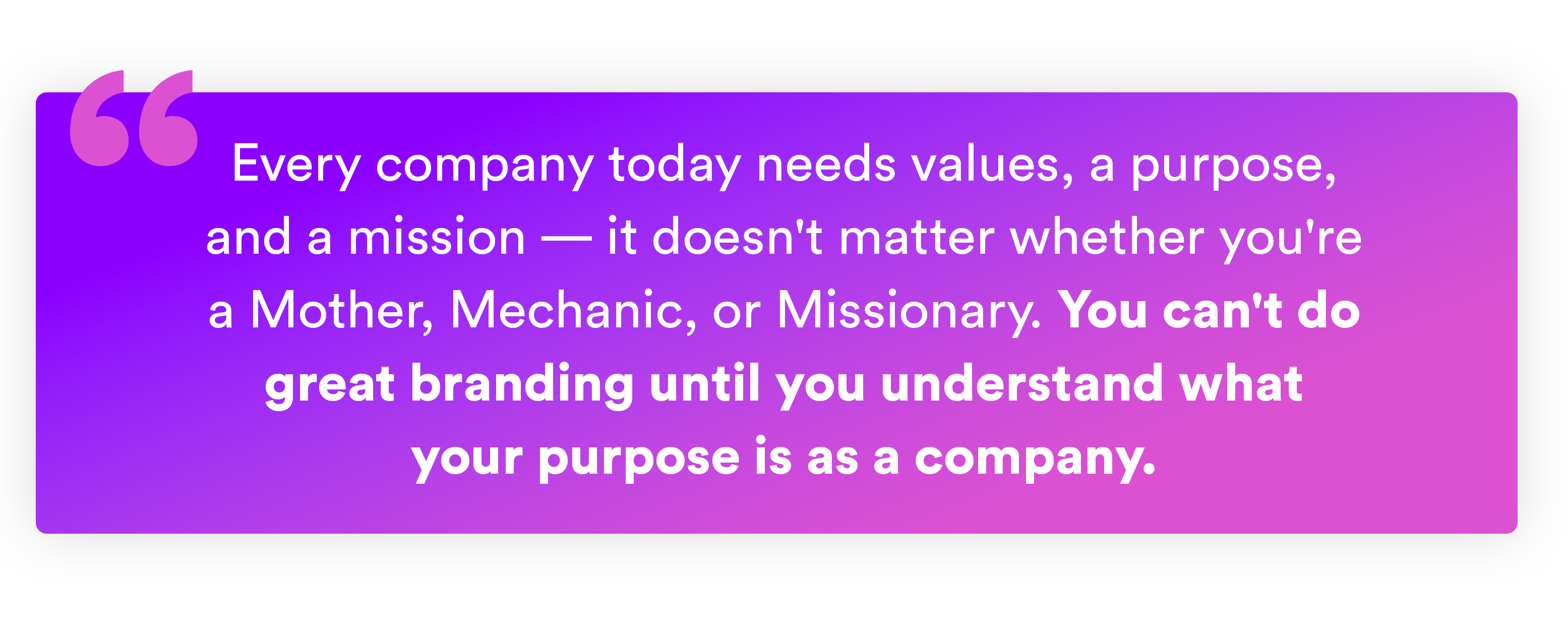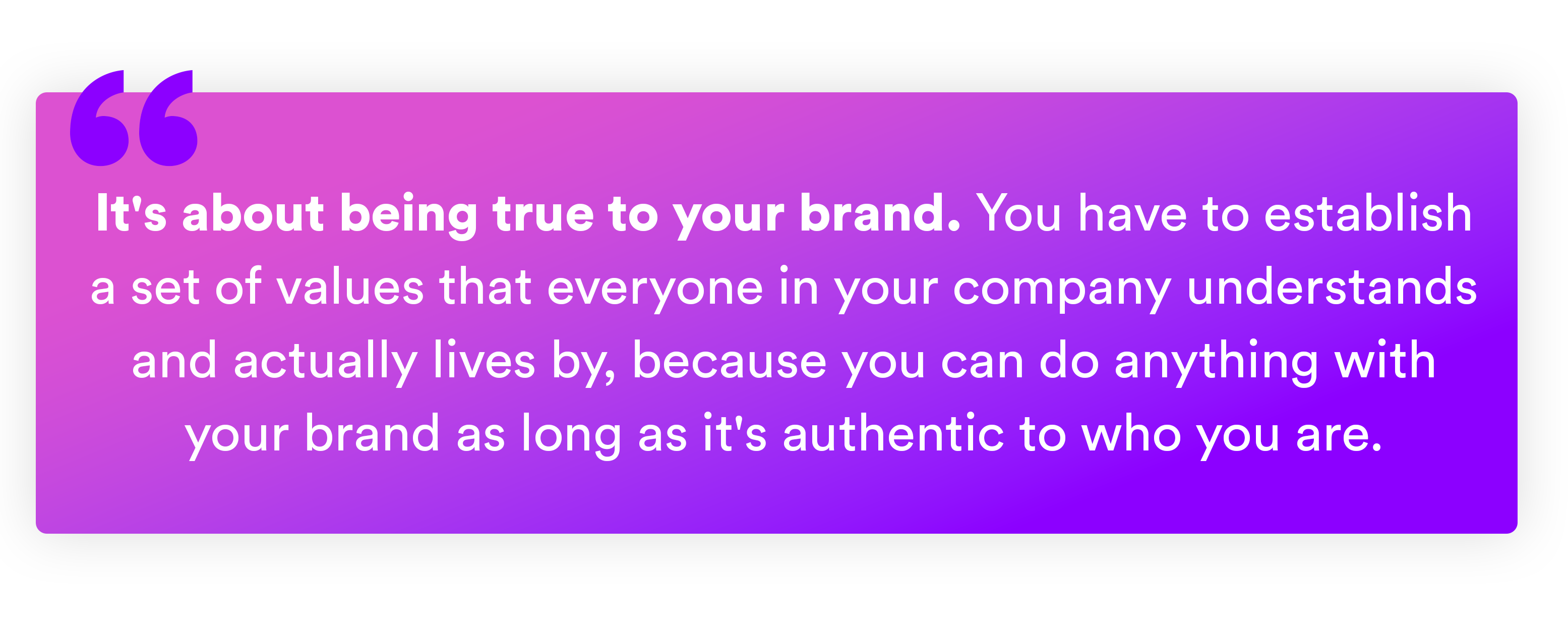What It Means to Be a Mission-Driven Brand with Andy Cunningham
Race relations. Climate change. Gender equality. These and other social, environmental, and public health issues have come center stage over the last several months, causing society as a whole to reevaluate the way we live. Never before have so many people questioned the impact their personal beliefs and everyday decisions have on others and the world around us — including where they choose to spend their money.
Today, more than 60% of consumers want companies to take a stand on social, cultural, political, and environmental issues. Consumers are 4-6x more likely to champion and trust purpose-driven brands. And 71% of consumers prefer buying from companies that align with their personal values.
From Victoria’s Secret to Nike, leading brands are reexamining their purpose and values and taking a mission-driven approach to marketing. But doing this in an authentic and consistent way that resonates with target consumers is much easier said than done. So, we consulted one of the country’s foremost positioning and branding experts: Andy Cunningham.
After coming to Silicon Valley to help Steve Jobs launch the original Macintosh, Andy has spent the last 30+ years developing marketing, branding, and communication strategies for some of the world’s leading companies. As an expert in helping brands accelerate growth, increase shareholder value, and advance their reputation, Andy has also written a best-selling book, founded the Cunningham Collective, started a marketing podcast, served on dozens of company and non-profit boards, and taught marketing classes at Harvard.
We sat down with Andy to learn more about company DNA, how this impacts a brand’s mission and values, ways to authentically convey brand purpose that drive employee and consumer loyalty, and much more.
Brandfolder: In your book, [Get to Aha](https://www.cunninghamcollective.com/get-to-aha)!, you explain that there are three types of companies: Mothers, Mechanics, and Missionaries. What are the differences between these DNA types, as you call them?
Andy: I have this underlying thesis that companies are a lot like people. I think they also have a DNA, which is typically ignited by the founders. That DNA should drive their behavior going forward because just like with humans, if you happen to have amazing natural talent to be a violinist or a basketball player, for example, it would serve you well to follow that DNA, rather than doing something completely different that you're not very good at.

To simplify it for companies, I divided the whole mass of the world into three DNA types using all of the companies that I had worked for in the past as my sample set. I call the first DNA type Mothers, and these companies are customer-centric. They put the customer first, and that’s how they structure themselves, what they talk about in meetings, and how they measure success.
Then there's a whole bunch of companies that focus on product domination, product leadership, and product functionality. I call them Mechanics. They tend to be very feature-driven, more aggressive, and measure success with regard to things like market share and sales.
The third type of company is a rare breed, and these are Missionaries. These companies exist to change human behavior and how the world operates on a fundamental level. Tesla today is a good example of this. Apple was a good example in the early days. Starbucks changed how we think about and pay for coffee. They’re typically run by a founder with a strong vision, and they tend to be very “cult of personality-esque.”

Brandfolder: How does a company’s DNA influence and shape its mission, purpose, and values?
Andy: A company’s DNA really is the foundational element of its position, which is the epicenter of great branding. Every company today needs values, a purpose, and a mission — it doesn't matter whether you're a Mother, Mechanic, or Missionary. You can't do great branding until you understand what your purpose is as a company. Then you move into the exercise of, "Okay, where's our role and relevance and how do we articulate it in the market, given this purpose and these values?"
Unfortunately, most companies jump right into logos, taglines, and other creative and emotional branding elements without first going through the rigor of defining who they are and why they matter. Figuring out a company’s values, purpose, mission, and spot on the map that they can credibly own — that’s the hard work of positioning. So, many of these branding attempts fail because they skipped over all this and were never true to who the brand was in the first place.
We all know that Nordstrom is a Mother that focuses entirely on the customer, right? You can pretty much return anything at Nordstrom, even if you didn't buy it there. They're all about customer relationships, success, and emotions, and they’ve done a really good job of actively conveying and living out those values.
But let’s look at another successful Mother company: Amazon. Jeff Bezos often says that Amazon is out to be Earth's most customer-centric company. They're not a warm and fuzzy company like Nordstrom, but they’re doing it through technology. They're trying to make sure that everything you want is available at the touch of a button. That's what Prime is all about. That's why they bought Zappos. Their brand and everything they do is driven by their mission and values and is a reflection of everything they are deep down.
Brandfolder: How do you think COVID and the various social justice movements that have occurred over the last 18 months have impacted the way that companies think about their market position and approach branding?
Andy: I think they’ve exacerbated and accelerated the need for companies to pay very close attention to things like their purpose and their mission. My generation, the Baby Boomers, grew up with this notion that we called shareholder value, and it was all about making money. Well, the Millennials taught us that there's more involved here than just shareholders: There are employees, partners, customers and all these other people that you have to pay attention to when you're building a company.
Now the bulk of employees, who are now Millennials and also Gen Zers, are really looking to companies and wondering, "Okay, why are we here? We're not here just to make money. What is our purpose? Why do we exist? What is our mission? What am I supposed to do every day in service of that purpose?" And this is a generation of people who can smell bullshit ten miles away. These can’t just be words. It has to be authentic. It has to be not only verbalized, but also acted out and then measured and then reported on.
There's a whole level of responsibility now associated with things like your purpose and your mission. Personally, I think that it's a wonderful thing and that having all of these companies focused on a purpose in addition to making money is going to actually accelerate the progress that we make on this planet.
Brandfolder: It’s becoming a trend for companies to do things like change their logo to a rainbow for Gay Pride Month or pink for breast cancer awareness. How can brands do things like this in an authentic way that resonates with their audience?
Andy: Let's talk about Patagonia for a minute. Patagonia is a great brand that pays attention to its purpose and is very authentic about it. If they decided to paint their logo rainbow during Pride, everybody would think, "That makes sense. What a cool thing to do!" But if some company, Comcast for example, decided to do that, it wouldn't have the same effect, right? People would be like, "What is that all about?"

It's about being true to your brand. You have to establish a set of values that everyone in your company understands and actually lives by, because you can do anything with your brand as long as it's authentic to who you are — which is why DNA is such an important thing to start with. It’s what gives you that authenticity. It’s like a map. What can you do and what can't you do? What should you do? What shouldn't you do? It's all inside of the company's DNA.
If your brand has a value around diversity, equity, and inclusivity, and you decide to paint your logo rainbow, people will understand and embrace that. But if you don't have those values and you're not living them and you can't show them to the world, then you shouldn't do something like that just for marketing purposes. Like, it wouldn’t make sense for Oracle or IBM to do something like that, because they’re very serious and aggressive. It’s not their personality. But it might make sense for Salesforce to, because they are much more spirited and fun.
Brandfolder: What sort of impact does genuine, purpose-driven branding have on a company’s customers? And what about its employees?
Andy: It really comes down to loyalty. You want your employees to remain loyal to you, and you want your customers to keep coming back. Your brand is about building loyalty with a certain base of people — and they shouldn’t just be employees and customers, but also board members, advisors, partners, potential customers, etc. You're really trying to build this place in a person's mind that doesn’t go away, and today that’s especially important because we have so much more stuff fighting for that real estate in our brains.
There was a book written in the 1970s called Positioning. They provide a very simple description of what positioning is, and I love it and use it all the time. And it’s that positioning is about staking out, owning, and protecting real estate in the mind of the customer or the potential customer. First, you’ve got to stake out the real estate. What is the place on the map that can belong to you and only you? Then you’ve got to own it. You’ve got to buy that real estate. Finally, you must defend and protect it. That's what positioning really is, and what the sort of great, mission-focused branding that comes out of it can ultimately achieve.
Brandfolder: How important is brand consistency to showing that the image you’re portraying is authentic, upholding your mission and values, and defending that space in people’s minds?
Andy: It’s probably the most important thing. Consistency is like the holy grail of marketing. In fact, you can even make a bad idea work really well if you’re consistent! Frequency is also extremely important. Consistency and frequency constantly reaffirm what it is you've put out there, and this is where almost all companies fall down. Because when you can't be consistent, you can't get stickiness. And when you don't get stickiness, you don't get awareness. And when you don't have awareness, you don't get people buying your stuff. It's just a problem that continues to exacerbate itself over and over again.

It is super hard for humans to be consistent — human beings are the frailty in this entire system. If it were just up to software, we wouldn’t have to worry about it. But it's people who are making decisions every single day about how to make brands go forward. And any single person who makes a decision that isn't consistent with the brand screws up the whole system and it all starts to fall apart. It's like being on an assembly line. Remember the I Love Lucy episode where she's on the chocolate assembly line? The minute one chocolate gets screwed up, the whole assembly line falls down. The same is true with marketing.
Brandfolder: Let’s say a brand wants to update its mission or its values to align with a deeper purpose or emerging social movement. What are some of the first steps they should take?
Andy: You have to have a plan and then you have to have people engaged in that plan. First get alignment among leadership, and then reexamine your corporate values and how the company's actually living them to see what’s really happening. If diversity, equity, and inclusion (DEI) really is a value, well, how are you living it? If transparency's really a value, how are you living it? You have to stand behind the values you publish. It all goes back to authenticity.
The pandemic, and race relations, and climate change, and all the issues that have come to the forefront of society over the last 18 months are causing brands to accelerate this reexamination of our values and our purpose as companies. If you haven't taken a step back and examined your values in the last couple of years, I would say it's time to do a refresh and truly dig into how they are being lived and measured. It’s critical to do all of that work before you do a positioning exercise or try to figure out your brand. After all, your brand is a reflection of your values and if you don’t have them or aren’t living them, your brand will form cracks. And a cracked brand is a broken brand.
Which brands are getting mission-focused messaging right? And what can we learn from them? Download our guide to learn 3 important lessons from a few brands that are showing us how it’s done.

